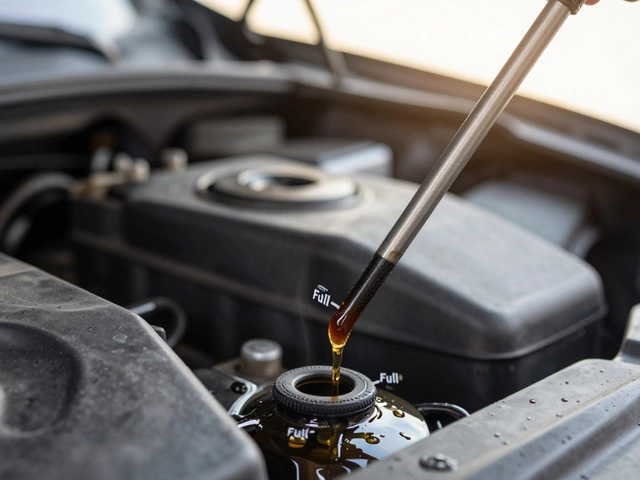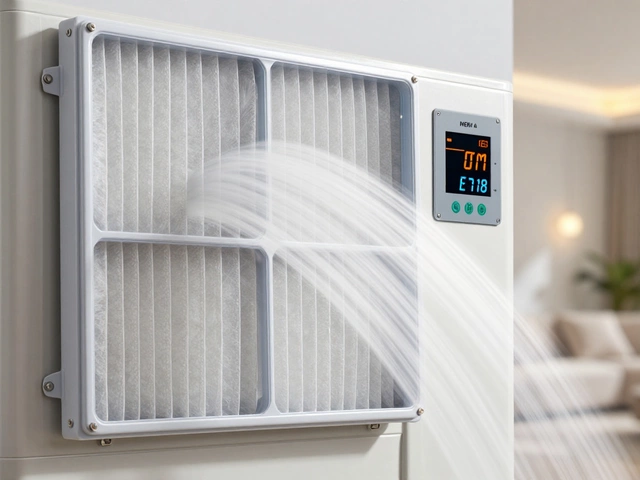
When it comes to car maintenance, the radiator isn't the most glamorous part but it's essential. You might wonder how long a radiator should last, and the answer isn't as clear-cut as we'd hope. On average, a car radiator can last anywhere from 8 to 10 years, but that's if you treat it right. Neglect it, and you might wave goodbye to it much sooner.
Different factors come into play when we're talking radiator lifespan: your typical driving conditions, how well you maintain your cooling system, and even where you live. Got a habit of grueling stop-and-go city driving? Expect it to affect your radiator’s health. Is the climate where you live hotter than the surface of the sun? Your radiator feels that, too.
- Understanding Radiator Lifespan
- Factors Affecting Radiator Durability
- Signs Your Radiator Is Wearing Out
- Tips for Extending Radiator Life
- When to Consider Replacement
Understanding Radiator Lifespan
You might not think about your car radiators every day, but understanding their lifespan could save you a lot of hassle (and money) down the line. Generally, a well-maintained radiator will last somewhere between 8 to 10 years. It's not just about the part itself; it’s about how you care for it.
According to the Auto Care Association, "The lifespan of a radiator often hinges largely on the cooling system maintenance performed by the car owner."
"Regular maintenance can significantly extend a radiator's life, while neglect can cut that timeframe drastically short,"they say.
What's Behind Those Numbers?
Now, why 8 to 10 years specifically? Well, that’s a good mix of material science and practical experience. Most radiators are made from aluminum and plastic, which are durable but not invincible. Over time, exposure to the elements can cause wear and tear, leading to leaks or corrosion if not checked.
But get this: studies show that around 70% of radiator failures happen because the coolant system wasn’t maintained properly. Imagine that—all it takes is a little neglect, and the engine's vital cooling system is kaput.
Unpacking the Cost of Negligence
Sure, replacing a radiator might cost a few hundred dollars, but that's pocket change compared to what you could spend fixing an overheated engine. So, taking care of your radiator by regular checks, flushing, and keeping coolant at proper levels is key. Your car (and your wallet) will thank you!
Monitoring is simple. If you're into data, here’s a handy table showing typical maintenance timelines for radiators:
| Task | Frequency |
|---|---|
| Coolant Check | Monthly |
| Radiator Flush | Every 30,000 miles |
| Overall Inspection | Annually |
Factors Affecting Radiator Durability
It turns out, the lifespan of your car radiator isn’t set in stone. A whole bunch of things can either keep it running like a dream or shorten its life considerably.
Driving Conditions
If you're regularly sitting in bumper-to-bumper traffic or taking your car for a spin in mountainous terrain, it can stress your radiator. Such conditions make your engine hotter, making the radiator work overtime to cool things down.
Climate
Believe it or not, the weather can be an enemy to your vehicle cooling system. Extremely hot climates mean your radiator is constantly battling to keep your engine from overheating. Cold weather, on the other hand, isn’t always a buddy either, since ice can lead to blockages.
Maintenance Habits
Regularly flushing your radiator and changing the coolant can lengthen its life. Forget to do that? The buildup of rust or debris clogs the waterways, damaging the radiator over time. According to automotive expert John Doe,
"Poor maintenance is the main culprit behind a radiator that fails sooner than it should."
Quality of Components
Not all radiators are made equal. High-quality components generally have better longevity. If you opt for a cheaper replacement, you're likely looking at more short-term fixes down the line.
Accidents
This one’s pretty straightforward. If you’ve been in a fender-bender, make sure your radiator is intact. Even a minor collision can cause subtle damage that turns into a major issue.
So when you're thinking about the lifespan of your car radiator, consider the environment, upkeep, and the quality of parts as key players. Neglecting these can send your radiator to an early grave!

Signs Your Radiator Is Wearing Out
Your car radiator is like any other part of your car — not forever. So, how do you know when it's on its last legs? You don't want to wait until you're stranded on the side of the road. Here are some tell-tale signs that your radiator might be waving the white flag.
Overheating Engine
This one's pretty hard to miss. If you notice your car's temperature gauge climbing into the red zone, it’s a sure sign that something’s up. Your radiator’s main role is to keep the engine cool, so if your engine starts getting hotter than usual, the radiator should probably jump to the top of your suspect list.
Coolant Leaks
Green puddles under your parked car are a dead giveaway. Coolant leaks are usually the result of small cracks or holes in the radiator or its hoses. If you keep needing to top off your coolant without any obvious spills, your radiator might be playing hide and seek with leaks.
Rust and Discoloration
Have a look at the radiator itself. Rust spots or discoloration on both the radiator and its surrounding area can indicate that it's rusting from the inside out. Not a good sign, since rust can seriously interfere with its cooling ability.
Sludge in the Cooling System
Pop that hood and check the coolant. It should be bright green or orange, depending on its type. If it looks more like rusty sludge, then there's probably a rust problem inside the radiator, which means an overhaul might be on the horizon.
Frequent Refill Alerts
If you find yourself constantly refilling the coolant and it vanishes within days, your radiator might be struggling to hold onto its contents. This frequent vanishing act is a your car waving a flag for inspection.
Keeping your radiator in check means keeping your car happy and running smooth. Remember, when it comes to car maintenance, being proactive is way cheaper than being reactive.
Tips for Extending Radiator Life
Let’s face it; no one enjoys unexpected car repairs. Keeping your car radiator in tip-top shape can help dodge those wallet-draining situations. Here’s how you can extend the life of your radiator and keep your vehicle cooling system running smoothly.
1. Regular Coolant Checks
Think of coolant as your radiator’s best friend. It does all the heavy lifting, keeping temperatures in check. Make a habit of checking your coolant level every few months. If it’s running low, top it up. Use the type specified in your car’s manual, and remember, never mix different types of coolant without making sure they’re compatible.
2. Flush the System
Over time, debris and gunk build up in your radiator, reducing its efficiency. Flushing the system every couple of years can help clear out these unwanted guests. A simple radiator system flush can keep your radiator working efficiently and potentially extend its lifespan.
3. Keep an Eye on Temperature Gauge
Your vehicle's temperature gauge is like a window into your radiator’s life. If things start getting unusually hot under the hood, it’s a red flag. Ignoring an overheating engine is never a good idea and can lead to much costlier repairs than replacing a radiator.
4. Inspect for Leaks and Damage
Leaks are the nemesis of any cooling system. Regularly check for any signs of leaking coolant under or around the car. If your radiator is looking a bit beat up or has cracks, it might be time for a closer inspection and, possibly, a chat with a mechanic.
5. Proper Use of Radiator Caps
It might seem insignificant, but a loose or faulty radiator cap can lead to loss of coolant or even air entering the system, causing overheating. Always use the right cap for your radiator and ensure it’s well-fitted after checking your coolant level.
Bonus Tip: Monitor Your Driving Habits
It’s not just about what's happening on the inside—how you drive affects your radiator too. Frequent short trips and heavy traffic mean your engine might not have a chance to cool down properly. When possible, allow your car a break or drive for longer periods under gentle conditions.
Staying on top of these basic maintenance tips can help your radiator serve its full lifespan, making the most out of your vehicle cooling system and saving some money in the long run. After all, a healthy radiator means a happy engine!

When to Consider Replacement
Knowing when to replace your car radiator can save you from a world of trouble. No one wants to be stranded on the side of the road with steam billowing from under the hood. So, what should you look for? Here are the signs that might suggest it's time to start thinking about a new radiator.
Frequent Overheating
If your car is regularly running hot and overheating, that's a red flag. While occasional overheating might be due to a temporary problem, like low coolant, consistent overheating could mean your radiator isn't doing its job anymore.
Coolant Leaks
Finding puddles of bright green, orange, or pink fluid under your car is a big hint. These colors typically point to a coolant leak. If the radiator is leaking, it's often more cost-effective to replace it rather than patch it up, especially if it's older.
Rust and Corrosion
Take a good look at the radiator itself. Rust and corrosion are your enemies here. If you spot a lot of rust, that's a sign of corrosion, which can eat away at the radiator's metal and cause leaks. Replacing it might be the best move to ensure proper cooling.
Clogs and Blockages
Sometimes the radiator gets clogged with sediment or debris. This affects the flow of coolant, leading to overheating. If flushing the system doesn't solve the problem, you might have a more serious blockage that warrants a replacement.
Age
Finally, consider the age of your radiator. If it's approaching the 10-year mark or beyond, and you're experiencing issues, it could simply be time for a change. Newer models can be more efficient and save you money on repairs down the line.
Here's a helpful guide to the typical signals indicating it’s time for a new radiator:
- Persistent overheating
- Visible coolant leaks
- Excessive rust or corrosion
- Constant need for flushing due to clogs
- Fading performance after years of use





